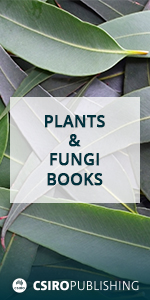
Functional Plant Biology
Volume 40 Number 5 2013
FP13061The mixotrophic nature of photosynthetic plants
Mixotrophy is deemed the exception in terrestrial plants, although there is mounting evidence that plants acquire organic compounds as sources of nutrients. Identifying the mechanisms involved in the acquisition of organic nutrients will provide understanding of the ecological significance of mixotrophy. Here, we discuss mixotrophy in the context of nitrogen and phosphorus nutrition drawing parallels between algae and plants.
FP12264Genetic variability in high temperature effects on seed-set in sorghum
The increasing frequency of extreme high temperature events threatens stable grain production. We explored the extent of genetic variability for the effect of high temperature on reproductive biology and seed-set in sorghum. The differences identified can be exploited through breeding to develop heat-tolerant varieties for future climates.
FP12272Expression profile of transcripts encoding cell wall remodelling proteins in tomato fruit cv. Micro-Tom subjected to 15°C storage
Tomato shelf life is usually limited to a few days; thus, tomatoes are kept at low temperatures to delay ripening and to extend fruit market life. Storage at 4°C caused chilling injury, storage at 15°C delayed ripening preserving fruit quality. In addition, cell wall metabolism is differentially affected at these temperatures. The identification of cell wall enzymes that are modified at 15°C will help in the identification of candidate genes involved in ripening delay but not in the development of chilling injury symptoms.
FP12287Effects of NaCl addition to the growing medium on plant hydraulics and water relations of tomato
Soil salinity is a major limiting factor for crop productivity. This work reports experimental evidence for a role of ion-mediated changes of xylem water transport in the functional response of tomato plants to moderate salinity levels. This is a novel finding with potentially important functional implications for plant physiology and breeding, as it offers a new perspective on plant interaction with salt stress and nutrient availability.
FP12245Effect of water stress on growth, water use efficiency and gas exchange as related to osmotic adjustment of two halophytes Atriplex spp.
The effect of water stress on growth and water utilisation was investigated in two Atriplex species: A. halimus and A. nummularia. Water stress induced a decrease in relative water content, water potential and CO2 assimilation for both species, but an increase in water use efficiency and a high accumulation of ABA and total sugars, mainly for A. halimus. Water stress resistance in A. halimus is linked to a higher water use efficiency rather than a greater osmotic adjustment.
FP12218Water and nutrient relationships between a mistletoe and its mangrove host under saline conditions
The present study provides the first physiological evidence in the water and nutrient relationships between a hemiparasitic mistletoe and its mangrove host under saline conditions. The mistletoe reduces its transpiration rates (Tr), and has a fundamental limitation in photosynthesis due to low stomatal conductance (gs) and mesophyll conductance (gm). The result still is consistent with the N-parasitism hypothesis, although the mistletoe has low Tr when the nitrogen supply is sufficient.
FP12147The regulation of antioxidant enzymes in two Plantago species differing in salinity tolerance under combination of waterlogging and salinity
Natural waterlogging affects vegetation dynamics in many areas of the world. We aimed to determine the tolerance mechanism of two different Plantago spp. having different salinity tolerance against waterlogging or the combination of salinity and waterlogging stress. Higher tolerance of Plantago maritima (salt-tolerant) than Plantago media (salt-sensitive) seemed to relate higher superoxide dismutase (SOD) and peroxidases (POX) activities. We suggest that a salt-tolerant species might also have a higher tolerance of the combination of waterlogging and salinity stress than a salt-sensitive one.
FP12250Exogenous abscisic acid reduces water loss and improves antioxidant defence, desiccation tolerance and transpiration efficiency in two spring wheat cultivars subjected to a soil water deficit
Drenching the soil with the phytohormone abscisic acid slowed the water use of two wheat cultivars subjected to drought and lowered the soil water content at which leaf hydration characteristics were affected. Desiccation tolerance and transpiration efficiency were increased at moderate levels of drought stress, but the grain yield was not increased by the phytohormone treatment. The wheat cultivar released recently maintained its leaf hydration to lower soil water contents and was more drought tolerant to moderate drought stress than an earlier-released cultivar.
FP12317Root distribution and demography in an avocado (Persea americana) orchard under groundcover management systems
Plants’ capacity to adjust to environmental stresses is a critical factor influencing their performance when living in mixed communities. The aim of our study was to explore root demography and distribution of avocado trees grown under different groundcover management systems. Our results showed that the avocado trees could adapt to more challenging growing conditions by growing less expensive and more efficient roots, with the trade-off of a shorter lifespan.
FP12290Genetic variation in the root growth response of barley genotypes to salinity stress
Soil salinity affects two-thirds of Australian cereal growing regions and results in reduced crop yields and massive losses in revenue. Barley is the fourth most important cereal crop worldwide. This study identifies genetic variation in root growth in barley in response to salinity stress. The identification of genetic diversity will be important in the future development of crop plants with enhanced salt tolerance.




